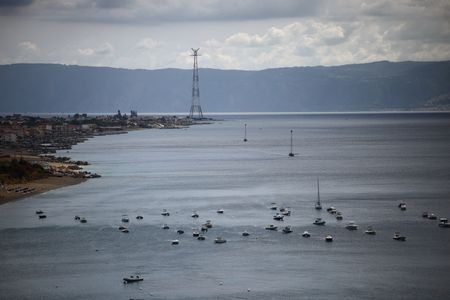ROME (Reuters) -Italy’s government gave final approval on Wednesday to the construction of what will be the world’s longest single-span bridge, connecting Sicily to the mainland, despite financial and environmental concerns that have delayed it for decades.
The right-wing government of Prime Minister Giorgia Meloni has set aside 13.5 billion euros ($15.63 billion) over the next 10 years to build it and surrounding facilities.
Following are key facts about the bridge, based on data from the construction company Webuild and Italy’s Infrastructure Ministry.
Webuild leads the Eurolink consortium, which has been awarded the contract to design and build the Messina Strait Bridge. Also the Spanish group Sacyr and Japanese group IHI are members of the consortium:
TOTAL LENGTH
The bridge is planned to be the world’s longest suspension bridge, with a total length of 3.7 km (2.3 miles) and a suspended span of 3.30 km (2.05 miles).
DECK WIDTH
The deck will be around 60 metres wide, with six road lanes (three in each direction), two railway tracks and two service lanes.
There will be two towers, each made entirely of highly resistant steel, standing 399 metres tall and weighing 55,000 tonnes. Each tower will consist of two legs connected by three crossbeams.
The towers will be set in two circular reinforced concrete footings, which will be connected by a crossbeam. The Sicily tower will have a diameter of 55 metres and the Calabria tower will have a diameter of 48 metres.
There will be four main cables, each with a diameter of 1.26 metres and made up of 44,323 steel wires.
The bridge is expected to remain stable in winds of up to 292 km/h and has a design lifespan of 200 years.
The bridge will be open 24 hours a day, 365 days a year.
INFRASTRUCTURE
The project includes the construction of more than 40 km of new roads and railways, mostly in tunnels, as well as three new underground stations in the Sicilian town of Messina.
The clearance above sea level is 72 metres, reducing to 70 metres under full load.
SAFETY
The bridge has been designed to withstand major earthquakes and winds that far exceed historical records for the area.
TIMELINE
Construction is expected to take around seven years, with a possible opening in 2032–33.
($1 = 0.8620 euros)
(Reporting by Francesca Piscioneri, editing by Gareth Jones)











